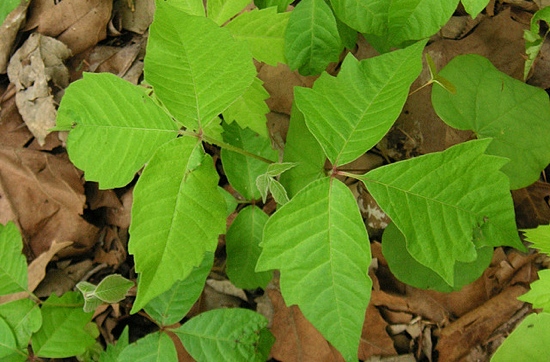Leaves of three, let it be
There’s a lot to love about summer. Poison ivy? Not so much.

Original — July 02, 2014
Poison ivy1 makes its home in Asia and North America and affects over 350,000 people annually in the US. Many of us know it well.
“It’s everywhere,” said Peggy Singlemann, Director of Horticulture at Maymont and co-host of WCVE’s Virginia Home Grown radio show. “It’s a common native plant here in the Richmond area, and all of Virginia for that matter.”
Singlemann doesn’t mince words about poison ivy’s hazards. “This is not a plant to take lightly,” she said.
Don’t hate the player, hate the allergen
Poison ivy would be another ho-hum plant if it weren’t for urushiol, the clear sappy liquid it exudes. Urushiol’s potent stuff: you need just the amount that fits onto the head of a pin to infect 500 people.
Roughly 15 percent of the population is unfazed by urushiol and will never develop a reaction to it (yay!). Unfortunately, for those who are affected by urushiol, repeated exposure often makes subsequent rashes worse (boo!).
If you do touch poison ivy, Singleman recommends you wash the spots with Tecnu, the wash used by Maymont employees. “Soap and water will not take this oil off,” she said. It’s best to use the wash within six hours of exposure.
After coming into contact with poison ivy, do your best to quarantine the part of you body exposed to it. “The [urushiol] can attach to your clothing and your pet’s fur,” Singlemann said. “The oil is so persistent. It doesn’t go away.” Immediately wash the clothing you were wearing when you were exposed.
If a rash develops,2 take an antihistamine (Benadryl) to ease itching and use a topical cortisone ointment (Cortisone-10) to reduce inflammation.
How do I spot poison ivy?
“Leaves of three, let it be.” It’s true: poison ivy leaves do grow in bunches of three. But leaves can be smooth or jagged, making poison ivy tricky to spot. To make it more challenging, leaves are green in spring and summer, but change color in autumn with the fall foliage.
Each poison ivy leaflet grows on its own stem that connects to the main vine. “There’s a definite sheen to it,” Singlemann said, describing the leaves. “It’s got a little shine.”
Singlemann said there’s often a reddish dot where the three leaves come together. “That tends to stand out pretty quickly for people,” she said.
Another tell is that poison ivy stems are often brown, not green like other native plants. Poison ivy stems often have dark brown hair-like tendril, especially when the plant is climbing up something, like a wall or tree.
Poison ivy also lacks thorns, and will sometimes gave berry-like drupes that are green at first and become white and waxy.
And just because you see animals touching or eating leaves, that doesn’t mean they’re OK for us. Animals can graze on poison ivy with no ill-effects.
How do I deal with the stuff?
“Poison ivy is everywhere in our community,” Singlemann said. “I think we all need to understand it’s out there.” Wear pants, long sleeves, and gloves when you’re doing yard work or hiking.
If you spot poison ivy in your yard, don’t burn the plant. “The oil does travel in the smoke,” she said. If inhaled, urushiol can irritate and swell your lungs.
Despite its many drawbacks, poison ivy does have an upside. Some argue that poison ivy-ridden Fire Island off Long Island in New York was named not only for the plant’s fiery itch, but for its reddish beauty in autumn.
“There’s always a silver lining,” Singlemann said.
Related
photo by Beatrice Murch
- Toxicodendron radicans for you botanists in the audience. ↩
- Some people may develop blisters after exposure to poison ivy. If that happens, GO TO A DOCTOR. ↩
-
Recommend this
on Facebook -

Report an error
-

Subscribe to our
Weekly Digest





Notice: Comments that are not conducive to an interesting and thoughtful conversation may be removed at the editor’s discretion.
Nice article, Peggy!
Jewelweed is a good plant to know- often grows near poison ivy and works well to prevent getting a rash and, if you get one, treating it http://www.wildmanstevebrill.com/Plants.Folder/Jewelweed.html